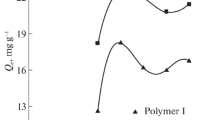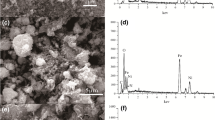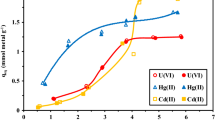Abstract
Mercury emissions from the industrial sector have become an undeniable concern for researchers due to their toxic health effects. Efforts have been made to develop green, efficient, and reliable methods for removal of mercury from wastewater. Sorption process promises fruitful results for the decontamination of cations from wastewater. Among the number of used sorbents, metal sulfides have been emerged as an appropriate material for removing toxic metals that possess good affinity due to sulfur-based active sites for Hg through “Lewis’s acid-based soft–soft interactions.” Herein, nickel-sulfide nanoparticles were synthesized, followed by their incorporation in chitosan microspheres. FTIR analysis confirmed the synthesis of nickel sulfide-chitosan microspheres (NiS-CMs) displaying sharp bands for multiple functional groups. XRD analysis showed that the NiS-CMs possessed a crystallite size of 42.1 nm. SEM analysis indicated the size of NiS-CMs to be 950.71 μm based on SEM micrographs. The sorption of mercury was performed using the NiS-CMs, and the results were satisfactory, with a sorption capacity of 61 mg/g at the optimized conditions of pH 5.0, 80 ppm concentration, in 60 min at 25 °C. Isothermal models and kinetics studies revealed that the process followed pseudo-second-order kinetics and the Langmuir isothermal model best fitted to experimental data. It was concluded that the NiS-CMs have emerged as the best choice for removing toxic mercury ions with a positive impact on the environment.












Similar content being viewed by others
Data availability
Not applicable.
References
Ali N, Riead MMH, Bilal M, Yang Y, Khan A, Ali F, ..., Iqbal HM (2021) Adsorptive remediation of environmental pollutants using magnetic hybrid materials as platform adsorbents. Chemosphere284:131279
Allouche FN (2021) A user-friendly Ulva lactuca/chitosan composite bead for mercury removal. Inorg Chem Commun 130:108747
AlMalki MA, Khan ZA, El-Said WA (2021) Synthesis and characterization of Nickel sulfide and Nickel sulfide/Molybdenum disulfide nanocomposite modified ITO electrode as efficient anode for methanol electrooxidation. Applied Surface Science Advances 6:100187
Bachand SM, Kraus TE, Stern D, Liang YL, Horwath WR, Bachand PA (2019) Aluminum- and iron-based coagulation for in-situ removal of dissolved organic carbon, disinfection byproducts, mercury and other constituents from agricultural drain water. Ecol Eng 134:26–38
Butwong N, Kunthadong P, Soisungnoen P, Chotichayapong C, Srijaranai S, Luong JH (2018) Silver-doped CdS quantum dots incorporated into chitosan-coated cellulose as a colorimetric paper test stripe for mercury. Microchim Acta 185(2):1–9
Dai D, Yang J, Wang Y, Yang YW (2021) Recent progress in functional materials for selective detection and removal of mercury (II) ions. Adv Func Mater 31(1):2006168
Das SK, Das AR, Guha AK (2007) A study on the adsorption mechanism of mercury on Aspergillus versicolor biomass. Environ Sci Technol 41(24):8281–8287
Eltarahony M, Zaki S, Abd-El-Haleem D (2020) Aerobic and anaerobic removal of lead and mercury via calcium carbonate precipitation mediated by statistically optimized nitrate reductases. Sci Rep 10(1):1–20
Fang R, Lu C, Zhong Y, Xiao Z, Liang C, Huang H, ... , Zhang W (2020) Puffed rice carbon with coupled sulfur and metal iron for high-efficiency mercury removal in aqueous solution. Environ Sci Technol 54(4):2539-2547
Fausey CL, Zucker I, Lee DE, Shaulsky E, Zimmerman JB, Elimelech M (2020) Tunable molybdenum disulfide-enabled fiber mats for high-efficiency removal of mercury from water. ACS Appl Mater Interfaces 12(16):18446–18456
Fazli Y, Pourmortazavi SM, Kohsari I, Karimi MS, Tajdari M (2016) Synthesis, characterization and photocatalytic property of nickel sulfide nanoparticles. J Mater Sci: Mater Electron 27(7):7192–7199
Foroutan R, Mohammadi R, Farjadfard S, Esmaeili H, Ramavandi B, Sorial GA (2019) Eggshell nano-particle potential for methyl violet and mercury ion removal: surface study and field application. Adv Powder Technol 30(10):2188–2199
Foroutan R, Peighambardoust SJ, Ahmadi A, Akbari A, Farjadfard S, Ramavandi B (2021) Adsorption mercury, cobalt, and nickel with a reclaimable and magnetic composite of hydroxyapatite/Fe3O4/polydopamine. J Environ Chem Eng 9(4):105709
Fu W, Ji G, Chen H, Yang S, Guo B, Yang H, Huang Z (2020) Molybdenum sulphide modified chelating resin for toxic metal adsorption from acid mine wastewater. Sep Purif Technol 251:117407
Ghasemi SS, Hadavifar M, Maleki B, Mohammadnia E (2019) Adsorption of mercury ions from synthetic aqueous solution using polydopamine decorated SWCNTs. J Water Proc Eng 32:100965
Han Y, Tao J, Khan A, Ullah R, Ali N, Ali N, Malik S, Yu C, Yang Y Bilal M (2022) Design and fabrication of chitosan cross-linked bismuth sulfide nanoparticles for sequestration of mercury in river water samples. Environ Res 215:113978
Huang S, Ma C, Liao Y, Min C, Du P, Jiang Y (2016) Removal of mercury (II) from aqueous solutions by adsorption on poly (1-amino-5-chloroanthraquinone) nanofibrils: equilibrium, kinetics, and mechanism studies. J Nanomater 2016:724829
Hussain S, Gul S, Khan S, Rehman HU, Ishaq M, Khan A, ..., Din Z U (2015) Removal of Cr (VI) from aqueous solution using brick kiln chimney waste as adsorbent. Desalination Water Treat 53(2):373-381
Hussain S, Ullah Z, Gul S, Khattak R, Kazmi N, Rehman F, ..., Khan A (2016) Adsorption characteristics of magnesium-modified bentonite clay with respect to acid blue 129 in aqueous media. Pol J Environ Stud 25(5):1947-1953
Jeon C, Park KH (2005) Adsorption and desorption characteristics of mercury (II) ions using aminated chitosan bead. Water Res 39(16):3938–3944
Khan A, Wahid F, Ali N, Badshah S, Airoldi C (2015) Single-step modification of chitosan for toxic cations remediation from aqueous solution. Desalin Water Treat 56(4):1099–1109
Khan M, Khan A, Khan H, Ali N, Sartaj S, Malik S, ... , Bilal M (2021) Development and characterization of regenerable chitosan-coated nickel selenide nano-photocatalytic system for decontamination of toxic azo dyes. Int J Biol Macromol 182:866-878
Kim Y, Lin Z, Jeon I, Van Voorhis T, Swager TM (2018) Polyaniline nanofiber electrodes for reversible capture and release of mercury (II) from water. J Am Chem Soc 140(43):14413–14420
Kristl M, Dojer B, Gyergyek S, Kristl J (2017) Synthesis of nickel and cobalt sulfide nanoparticles using a low cost sonochemical method. Heliyon 3(3):e00273
Li N, Bai R, Liu C (2005) Enhanced and selective adsorption of mercury ions on chitosan beads grafted with polyacrylamide via surface-initiated atom transfer radical polymerization. Langmuir 21(25):11780–11787
Liu D, Du H, Zhang J, Que G (2015) Reverse microemulsion synthesis and characterization of nano nickel sulfide catalyst for residue slurry-phase hydrocracking. Energy Fuels 29(5):3353–3358
Liu D, Li B, Wu J, Liu Y (2021) Elemental mercury capture from industrial gas emissions using sulfides and selenides: a review. Environ Chem Lett 19(2):1395–1411
Liu Z, Sun Y, Xu X, Meng X, Qu J, Wang Z, ... , Qu B (2020) Preparation, characterization and application of activated carbon from corn cob by KOH activation for removal of Hg (II) from aqueous solution. BioresourTechnol 306:123154
Malik S, Khan A, Rahman G, Ali N, Khan H, Khan S, Sotomayor MD (2022) Core-shell magnetic molecularly imprinted polymer for selective recognition and detection of sunset yellow in aqueous environment and real samples. Environ Res 212:113209
Monyake KC, Alagha L (2022) Enhanced separation of base metal sulfides in flotation systems using Chitosan-grafted-Polyacrylamides. Sep Purif Technol 281:119818
Ochedi FO, Liu Y, Hussain A (2020) A review on coal fly ash-based adsorbents for mercury and arsenic removal. J Clean Prod 267:122143
Pohl A (2020) Removal of heavy metal ions from water and wastewaters by sulfur-containing precipitation agents. Water Air Soil Pollut 231(10):1–17
Prasetya A, Prihutami P, Warisaura AD, Fahrurrozi M, Petrus HTBM (2020) Characteristic of Hg removal using zeolite adsorption and Echinodorus palaefolius phytoremediation in subsurface flow constructed wetland (SSF-CW) model. J Environ Chem Eng 8(3):103781
Qiao Q, Singh S, Lo SL, Srivastava VC, Jin J, Yu Y, Wang L (2021) Sorption/desorption of aqueous mercury ions [Hg2+] onto/from sulfur-impregnated attapulgite: process optimization, co-existing anions and regeneration studies. J Taiwan Inst Chem Eng 119:204–212
Rabie AM, Abd El-Salam HM, Betiha MA, El-Maghrabi HH, Aman D (2019) Mercury removal from aqueous solution via functionalized mesoporous silica nanoparticles with the amine compound. Egyptian Journal of Petroleum 28(3):289–296
Salavati-Niasari M, Banaiean-Monfared G, Emadi H, Enhessari M (2013) Synthesis and characterization of nickel sulfide nanoparticles via cyclic microwave radiation. C R Chim 16(10):929–936
Samani MR, Toghraie D (2020) Using of polyaniline–polyvinyl acetate composite to remove mercury from aqueous media. International Journal of Environmental Research 14(3):303–310
Shellaiah M, Sun KW (2021) Progress in metal-organic frameworks facilitated mercury detection and removal. Chemosensors 9(5):101
Sun Y, Lv D, Zhou J, Zhou X, Lou Z, Baig SA, Xu X (2017) Adsorption of mercury (II) from aqueous solutions using FeS and pyrite: a comparative study. Chemosphere 185:452–461
Tang J, Ptacek CJ, Blowes DW, Liu Y, Feng Y, Finfrock YZ, Liu P (2022) Mercury adsorption kinetics on sulfurized biochar and solid-phase digestion using aqua regia: a synchrotron-based study. Chem Eng J 428:131362
Trikkaliotis DG, Christoforidis AK, Mitropoulos AC, Kyzas GZ (2020) Adsorption of copper ions onto chitosan/poly (vinyl alcohol) beads functionalized with poly (ethylene glycol). Carbohyd Polym 234:115890
Tuzen M, Sarı A, Turkekul I (2020) Influential bio-removal of mercury using Lactarius acerrimus macrofungus as novel low-cost biosorbent from aqueous solution: isotherm modeling, kinetic and thermodynamic investigations. Mater Chem Phys 249:123168
Wang L, Hou D, Cao Y, Ok YS, Tack FM, Rinklebe J, O’Connor D (2020) Remediation of mercury contaminated soil, water, and air: a review of emerging materials and innovative technologies. Environ Int 134:105281
Wu S, Yan P, Yu W, Cheng K, Wang H, Yang W, ... , Che L (2019) Efficient removal of mercury from flue gases by regenerable cerium-doped functional activated carbon derived from resin made by in situ ion exchange method. Fuel Proc Technol 196:106167
Xiang Y, Zhu A, Guo Y, Liu G, Chen B, He B, ... , Jiang G (2022) Decreased bioavailability of both inorganic mercury and methylmercury in anaerobic sediments by sorption on iron sulfide nanoparticles. J Hazard Mater 424:127399
Xie X, Zhang Z, Chen Z, Wu J, Li Z, Zhong S, ... , Zhilou L (2022) In-situ preparation of zinc sulfide adsorbent using local materials for elemental mercury immobilization and recovery from zinc smelting flue gas. Chem Eng J 429:132115
Yang W, Adewuyi YG, Hussain A, Liu Y (2019) Recent developments on gas–solid heterogeneous oxidation removal of elemental mercury from flue gas. Environ Chem Lett 17(1):19–47
Yang R, Li R, Zhang L, Xu Z, Kang Y, Xue P (2020) Facile synthesis of hollow mesoporous nickel sulfide nanoparticles for highly efficient combinatorial photothermal–chemotherapy of cancer. J Mater Chem B 8(34):7766–7776
Ye D, Wang X, Wang R, Wang S, Liu H, Wang H (2021) Recent advances in MnO2-based adsorbents for mercury removal from coal-fired flue gas. J Environ Chem Eng 9(5):105993
Zhang S, Malik S, Ali N, Khan A, Bilal M, Rasool K (2022) Covalent and non-covalent functionalized nanomaterials for environmental restoration. Top Curr Chem 380(5):1–113
Funding
The research leading to these results has received funding from the Norwegian Financial Mechanism 2014–2021 under the Project number 2020/37/K/ST8/03805.
Author information
Authors and Affiliations
Contributions
YH, JT, AK: conceptualization, data analysis and curation, project administration, supervision, validation, writing—original draft, review and editing. AK, SM: investigation, methodology, data analysis and curation. NA: co-supervision, conceptualization. AK: validation, writing—review and editing. CY, YY: data analysis, writing—review and editing. TJ: formal analysis, writing—review and editing. MB: data analysis, software, visualization, validation, writing—review and editing, supervision.
Corresponding author
Ethics declarations
Ethics approval
Not applicable.
Consent to participate
Not applicable.
Consent of publication
Not applicable.
Competing interests
Not applicable.
Additional information
Responsible Editor: George Z. Kyzas
Publisher's note
Springer Nature remains neutral with regard to jurisdictional claims in published maps and institutional affiliations.
Rights and permissions
Springer Nature or its licensor (e.g. a society or other partner) holds exclusive rights to this article under a publishing agreement with the author(s) or other rightsholder(s); author self-archiving of the accepted manuscript version of this article is solely governed by the terms of such publishing agreement and applicable law.
About this article
Cite this article
Han, Y., Tao, J., Khan, A. et al. Development of reusable chitosan-supported nickel sulfide microspheres for environmentally friendlier and efficient bio-sorptive decontamination of mercury toxicant. Environ Sci Pollut Res 30, 47077–47089 (2023). https://doi.org/10.1007/s11356-022-24563-8
Received:
Accepted:
Published:
Issue Date:
DOI: https://doi.org/10.1007/s11356-022-24563-8




